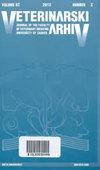Comparison of lidocaine and its combination with ketamine for distal intravenous regional anesthesia (DIVRA) in bovines
IF 0.3
4区 农林科学
Q4 VETERINARY SCIENCES
引用次数: 0
Abstract
The hoof diseases of cattle can be managed surgically under intravenous regional anesthesia (IVRA). For routine induction of IVRA, a tourniquet is placed circumferentially at the metacarpus/metatarsus. In the present study, hoof diseases of cattle were corrected using a modified IVRA technique. The cattle with hoof ailments were randomly divided into two groups and a tourniquet was placed just distal to the dew claws instead of at the metacarpus/metatarsus in order to decrease the dose of anesthetic. In group I lidocaine (2mg/kg) and in group II a mixture of lidocaine and ketamine (2mg/kg+1.5mg/kg) was injected into the axial digital vein to induce distal intravenous regional anesthesia (DIVRA). The heart rate, respiration rate, systolic and diastolic pressure were unaffected in both groups. Oxygen saturation was significantly (P<0.05) lower between 5 and 60 minutes in group I and between 15and 40 minutes in group II animals. The sensory and motor block onset time was shorter, and the sensory and motor block recovery time was longer in group II animals as compared to group I animals. It was concluded that the DIVRA technique using lidocaine alone and lidocaine admixed with ketamine are suitable for hoof examination and surgery.利多卡因与氯胺酮联合用于牛远端静脉区域麻醉的比较
牛蹄病可在静脉局部麻醉(IVRA)下进行手术治疗。常规诱导IVRA时,在掌骨/跖骨周围放置止血带。本研究采用改良的IVRA技术对牛蹄病进行了校正。患有蹄疾的牛被随机分为两组,止血带被放置在露爪的远端,而不是在掌/跖骨上,以减少麻醉剂量。ⅰ组采用利多卡因(2mg/kg),ⅱ组采用利多卡因与氯胺酮的混合(2mg/kg+1.5mg/kg)注入指轴静脉诱导远端静脉区域麻醉(DIVRA)。两组患者的心率、呼吸频率、收缩压和舒张压均未受影响。ⅰ组动物在5 ~ 60 min和ⅱ组动物在15 ~ 40 min血氧饱和度显著降低(p < 0.05)。与ⅰ组相比,ⅱ组感觉和运动阻滞发作时间较短,恢复时间较长。结论:单独使用利多卡因及利多卡因与氯胺酮混合使用DIVRA技术适用于足部检查和手术。
本文章由计算机程序翻译,如有差异,请以英文原文为准。
求助全文
约1分钟内获得全文
求助全文
来源期刊

Veterinarski Arhiv
VETERINARY SCIENCES-
CiteScore
0.80
自引率
20.00%
发文量
22
审稿时长
6-12 weeks
期刊介绍:
The journal Veterinarski arhiv (Vet. arhiv) publishes original scientific papers, case reports, short communications, review papers and book reviews. Occasionally, in supplemental issues, it publishes papers of relevant conferences. The scope of the journal includes all fields of veterinary and animal sciences. Veterinarski arhiv is published by the Faculty of Veterinary Medicine University of Zagreb, six times a year, as an open access, peer-reviewed, international scientific journal. Only unpublished manuscripts may be accepted for the review process. All papers must be written in English and submitted via the Journal''s online submission system (COMET). The content of the Journal is available free of charge and there are no publication charges.
 求助内容:
求助内容: 应助结果提醒方式:
应助结果提醒方式:


